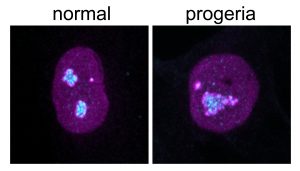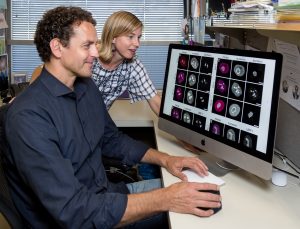
August 30, 2017
Overactive protein synthesis found in premature aging disease may also play role in normal aging
Overactive protein synthesis found in premature aging disease may also play role in normal aging
LA JOLLA—It may seem paradoxical, but studying what goes wrong in rare diseases can provide useful insights into normal health. Researchers probing the premature aging disorder Hutchinson-Gilford progeria have uncovered an errant protein process in the disease that could help healthy people as well as progeria sufferers live longer.
Scientists at the Salk Institute found that protein synthesis is overactive in people with progeria. The work, described in Nature Communications on August 30, 2017, adds to a growing body of evidence that reducing protein synthesis can extend lifespan—and thus may offer a useful therapeutic target to counter both premature and normal aging.
“The production of proteins is an extremely energy-intensive process for cells,” says Martin Hetzer, vice president and chief science officer of the Salk Institute and senior author of the paper. “When a cell devotes valuable resources to producing protein, other important functions may be neglected. Our work suggests that one driver of both abnormal and normal aging could be accelerated protein turnover.”

Click here for a high-resolution image.
Credit: Salk Institute
Hutchinson-Gilford progeria is a very rare genetic disease causing people to age 8 to 10 times faster than the rest of us and leading to an early death. The rare mutation occurs in one of the structural proteins in the cell nucleus, lamin A, but it has been unclear how a single defective protein in the nucleus causes the myriad rapid-aging features seen in the disease.
Initially, Salk Staff Scientist Abigail Buchwalter, first author of the paper, was interested in whether the mutation was making the lamin A protein less stable and shorter lived. After measuring protein turnover in cultured cells from skin biopsies of both progeria sufferers and healthy people, she found that it wasn’t just lamin A that was affected in the disease.
“We analyzed all the proteins of the nucleus and instead of seeing rapid turnover in just mutant lamin A and maybe a few proteins associated with it, we saw a really broad shift in overall protein stability in the progeria cells,” says Buchwalter. “This indicated a change in protein metabolism that we hadn’t expected.”
Along with the rapid turnover of proteins, the team found that the nucleolus, which makes protein-assembling structures called ribosomes, was enlarged in the prematurely aging cells compared to healthy cells.

Click here for a high-resolution image
Credit: Salk Institute
Even more intriguing, the team found that nucleolus size increased with age in the healthy cells, suggesting that the size of the nucleolus could not only be a useful biomarker of aging, but potentially a target of therapies to counter both premature and normal aging.
The work supports other research that appears in the same issue showing that decreasing protein synthesis extends lifespan in roundworms and mice. The Hetzer lab plans to continue studying how nucleolus size may serve as a reliable biomarker for aging.
“We always assume that aging is a linear process, but we don’t know that for sure,” says Hetzer, who also holds the Jesse and Caryl Philips Foundation Chair. “A biomarker such as this that tracks aging would be very useful, and could open up new ways of studying and understanding aging in humans.”
The work was funded by the National Institutes of Health, the Nomis Foundation, and the Glenn Center for Aging Research.
JOURNAL
Nature Communications
AUTHORS
Abigail Buchwalter and Martin W. Hetzer
Office of Communications
Tel: (858) 453-4100
press@salk.edu
Unlocking the secrets of life itself is the driving force behind the Salk Institute. Our team of world-class, award-winning scientists pushes the boundaries of knowledge in areas such as neuroscience, cancer research, aging, immunobiology, plant biology, computational biology and more. Founded by Jonas Salk, developer of the first safe and effective polio vaccine, the Institute is an independent, nonprofit research organization and architectural landmark: small by choice, intimate by nature, and fearless in the face of any challenge.